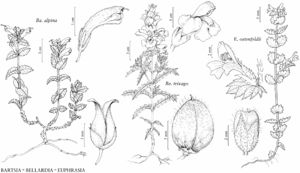Difference between revisions of "Bartsia alpina"
Sp. Pl. 2: 602. 1753.
FNA>Volume Importer |
FNA>Volume Importer |
||
| Line 59: | Line 59: | ||
|publication year=1753 | |publication year=1753 | ||
|special status=Selected by author to be illustrated | |special status=Selected by author to be illustrated | ||
| − | |source xml=https://jpend@bitbucket.org/aafc-mbb/fna-data-curation.git/src/ | + | |source xml=https://jpend@bitbucket.org/aafc-mbb/fna-data-curation.git/src/f6b125a955440c0872999024f038d74684f65921/coarse_grained_fna_xml/V17/V17_834.xml |
|genus=Bartsia | |genus=Bartsia | ||
|species=Bartsia alpina | |species=Bartsia alpina | ||
Revision as of 18:32, 24 September 2019
Perennials simple or branched, 10–30 cm. Leaves 4–10 pairs, divaricate; blade ovate, (5–)10–25 x (6–)9–17 mm, rugose, abaxial surface glabrescent to hirsute, adaxial glabrescent. Inflorescences with 2–8 pairs of flowers; bracts resembling foliage leaves, distal ones violet. Pedicels 2–4 mm. Flowers +/- divaricate, 15–20 mm; calyx green, often with violet markings, 5–9 mm, divided less than 1/2 length, hirsute; corolla scarcely curved, pilose, galea 3–5 mm, divided from abaxial lip less than 1/4 length of corolla, abaxial lip 2–3 mm; stamens included, 1/3–1/2 length of corolla from base, extending to abaxial lip; anthers white, equal, apex mucronate, villous; style 14–20 mm, stigma +/- exserted. Capsules ovoid, terete, 6–10 mm. Seeds 1.4–2 mm. 2n = 24.
Phenology: Flowering Jun–Aug.
Habitat: Subarctic and arctic tundra, lakeshores, fens.
Elevation: 0–1000 m.
Distribution
Greenland, Man., Nfld. and Labr., N.W.T., Nunavut, Ont., Que., Europe.
Discussion
Bartsia alpina has been reported to parasitize a wide range of hosts, including members of Ericaceae, Fabaceae, and Poaceae (U. Molau 1990). Outside the flora area, it occurs throughout northern Europe and in disjunct populations in the Alps and Pyrenees.
Bartsia alpina has been divided into varieties based primarily on variation in the color of the corolla. The most common form has violet corollas; other populations throughout the range occasionally include individuals with pale violet to yellow corollas. U. Molau (1990) reported that these forms are likely an expression of phenotypic variation induced by infection by either a gall fly or imperfect fungus.
Selected References
None.
